Durban Water and Sanitation For Poor Sets Global Standard
South African city’s water experimentation and innovation serves 1 million residents.
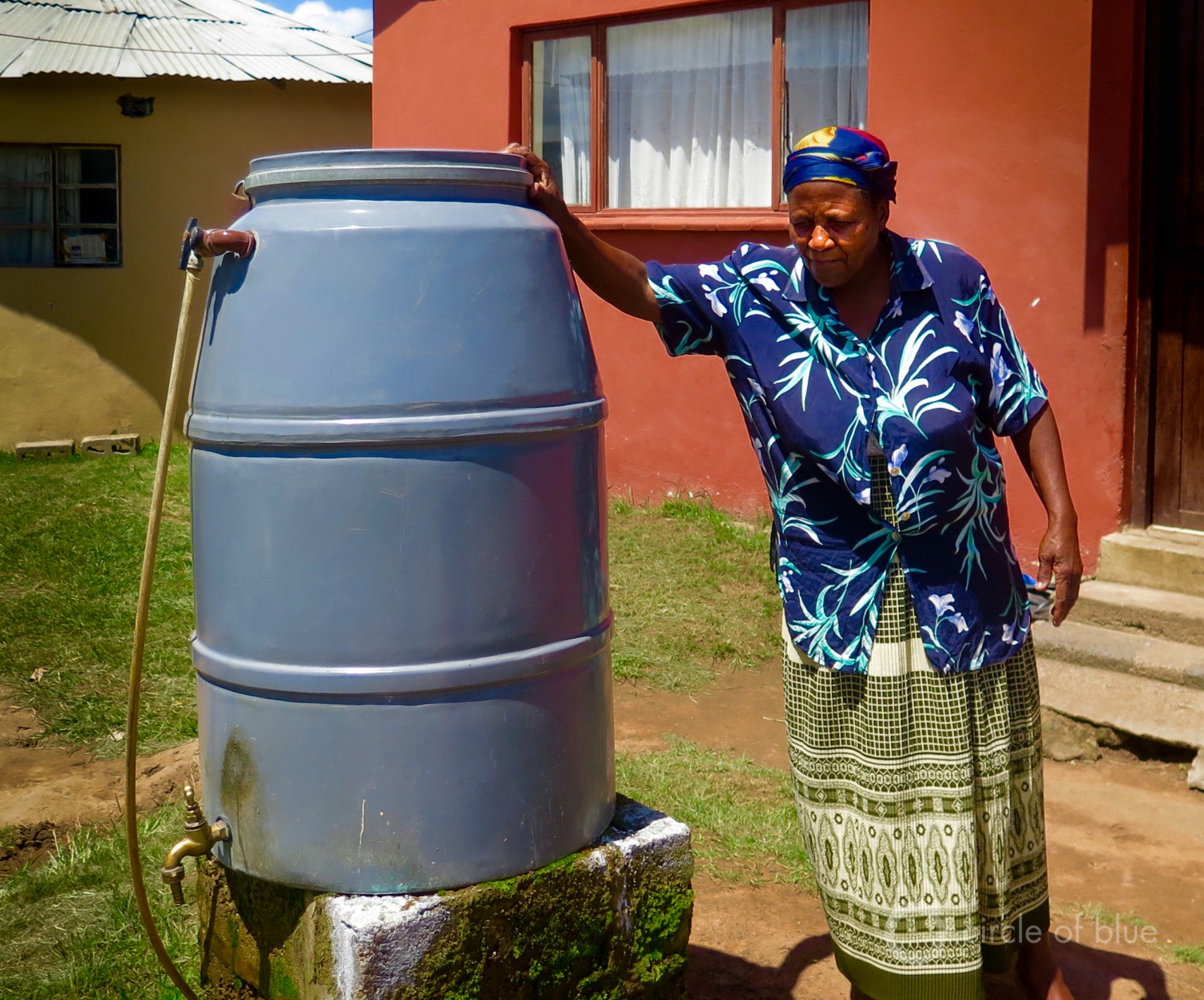
City water authorities have supplied tens of thousands of people living in Durban’s settlements with faucet standpipes and water tanks to supply fresh water. Photo © Keith Schneider / Circle of Blue
By Keith Schneider, Circle of Blue
DURBAN, South Africa — Arguably the most elegant aspect of an inelegant subject is how this city of 3.2 million residents, South Africa’s second largest, is solving monumental water and waste challenges in its jammed informal settlements.
The eThekwini (ett-ta-kweeny) Muncipality Water and Sanitation Department, Durban’s water and waste management provider, avoided huge and expensive equipment, big pipelines, and the complicated sewage disposal practices of centralized water and sanitation systems. Instead it deployed a decentralized strategy, partnerships, baseline research, and less expensive tools that worked.
The centerpiece of Durban’s program for the time being is the “community ablution block” public washroom. It is an ordinary marine cargo container refitted inside with running water in sinks and wash basins, toilets and showers. Durban has 2,500 ablution blocks installed in many of its nearly 500 informal settlements. There is sufficient public funding to fabricate and install perhaps 80 more annually.
Other innovations are the 85,000 urine-diverting toilets, standpipes, and water storage tanks installed outside settlement homes, a mobile sludge processing plant that sterilizes waste hauled from toilets and yields usable compost, and an aggressive program to clean wastes from pit toilets and then replace them.
A Moral Responsibility
The other ascendant feature of Durban’s program to provide fresh water, showers, and clean toilets to more than 1 million residents in the city’s corrugated metal and wood-sided settlements is that city leaders view their efforts as a moral responsibility. So many other big cities — Cairo, Delhi, Lima, Manila, Mexico City, Mumbai, Nairobi, Ulan Bator — don’t really care.
“The city decided it’s our responsibility to service these areas.”
— Teddy Gounden,
Acting project manager, eThekwini Water and Sanitation
Influenced by cost considerations and class neglect, leaders of these and so many other cities in the developing world decided long ago to ignore the water needs of the great hordes of new residents pouring in from the countryside to seek jobs. They crowd dirty and dangerous slums and spend too much of their time appealing to city governments for basic water and sanitation. Without it, parents and children rely on contaminated water, much of it collected from rooftops, and defecate in the horror show of open pits. More than 2.4 billion people, the United Nations says, live this way.
Not in Durban.
“The city decided it’s our responsibility to service these areas,” said Teddy Gounden, the acting project manager for the municipality’s Water and Sanitation unit. “People demanded our service. One third of the more than 3 million people who live here are in the settlements. It was not a good situation. It’s much better now.”
It has been said that the virtues of a nation truly cannot be known until the condition of its poorest residents are considered. A nation should not be judged by how it treats its privileged citizens, but by how it cares for its poorest. By that measure Durban’s water program is a recognized global leader, and a decided point of national pride in a country that is experiencing its worst days in the 22-year post-Apartheid era. Two years ago Durban was honored with the Stockholm Industry Water Award, one of the most prestigious prizes for water work in the public interest.
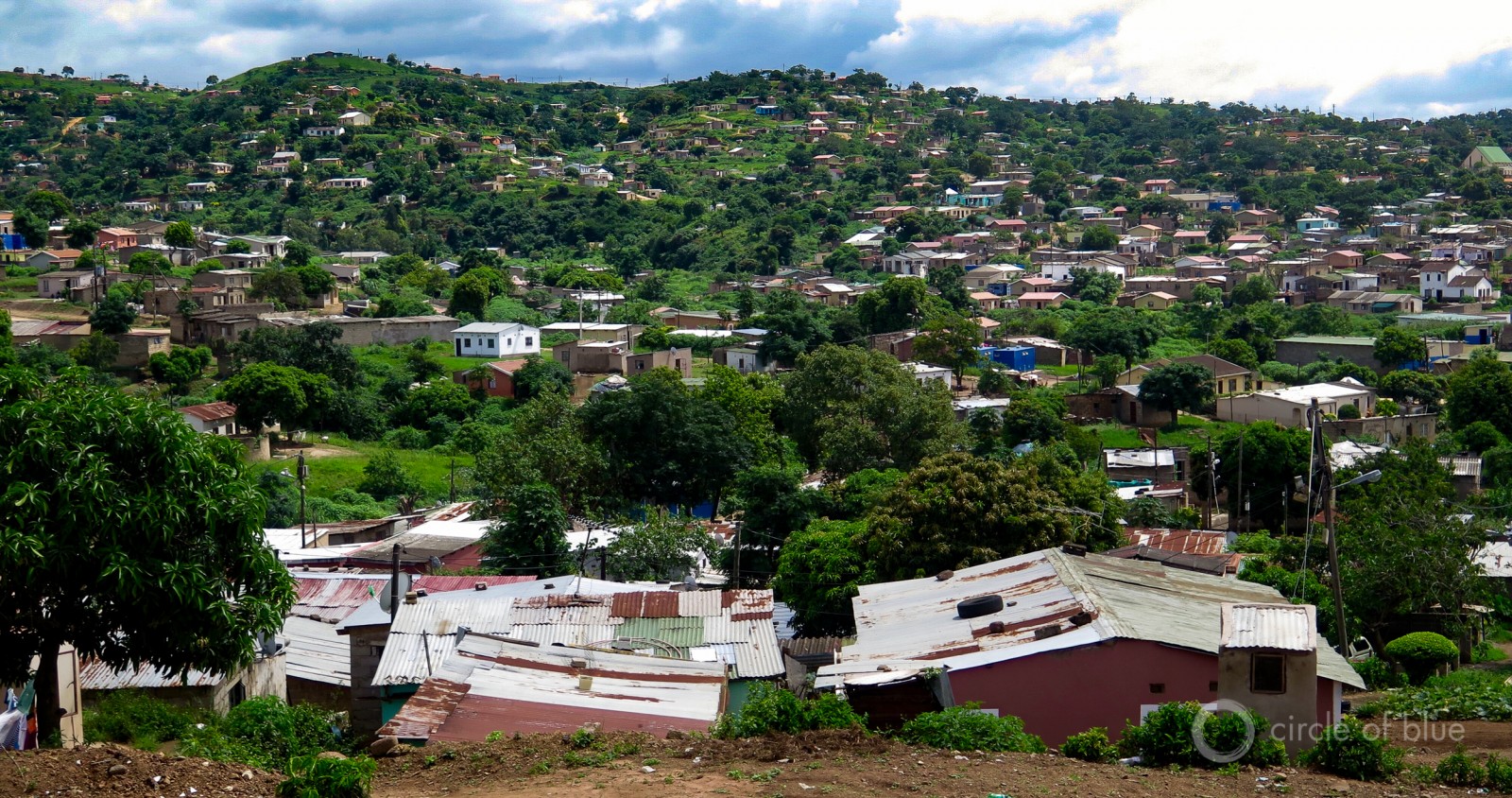
Durban is a city of hills and crowded settlements. The city is recognized as a global leader in providing its poor residents with fresh water and clean sanitation service. Photo © Keith Schneider / Circle of Blue
Influenced by surprising and destabilizing changes in the cabinet of President Jacob Zuma, and crashing commodity prices for the country’s mineral exports, the South African rand has slid in value to its lowest level ever, and is now worth barely more than 6 U.S. cents. The business confidence index fell in January to its worst-ever rating. National meteorologists projected that a deep drought, already a year old, will persist until the end of 2016. Agronomists project a massive crop failure that will necessitate importing half of South Africa’s grain. Layoffs in the farm sector caused by moisture scarcity and unplanted fields lifted the country’s persistent joblessness to more than 35 percent. Cities ran out of water last fall. Crime is endemic and getting worse.
The endowment of optimism and progress that South Africans embraced at the start of the new multi-racial elections and the formal end of Apartheid in 1994 has dissolved into a period of deepening economic and social stress.
Durban Pushes Through
Durban, a handsome and sunbright city of broad hills that cascade down to wide Indian Ocean beaches, has managed to push through the turmoil. In part that is due to the commitment to social justice and equity held by its leaders, and expressed in South Africa’s 1996 constitution. The special provisions that hold the nation accountable to ensure public access to clean water and sound health are globally unique.
The Bill of Rights declares that all South Africans “have the right to access to sufficient water and food.” The 1998 National Water Law requires water managers to provide “equitable allocation and beneficial use of water.”
“The city is behind this. Councilors support this. If you move around Durban you discover that people are happy with it.”
— Vusi Gebashe,
City councilor
Ward 55
“We can’t separate the approach eThekwini has taken from the policy of the country,” said Chris Buckley, a chemical engineering professor in the Pollution Research Group at Durban’s University of KwaZulu-Natal. “No other developing country has such a high priority on water and sanitation. If your national policies are different there is going to be a disconnect. The policy foundation supports innovation and problem-solving in Durban.”
Vusi Gebashe, a 51-year-old two-term city councilor from the city’s crowded Ward 55, said in an interview that he and his colleagues are very supportive of the water department. Its work in the informal settlements is viewed as a basic operating expense, like police and fire protection.
“The city supports this regardless of the next election and who is on the council,” he said. “We’ve been the main drivers of the project. It’s been like that for all ten years that I’ve been a councilor. The city is behind this. Councilors support this. If you move around Durban you discover that people are happy with it.”
Having secured a firm policy foundation and clear directive, the operational details of water supply and waste treatment became easier and more experimental in Durban. The starting point was a cholera epidemic in KwaZulu-Natal province in 2000. The city reacted quickly to install standpipes supplied with water from its extensive drinking water transport network. It built large pit toilets, locating them strategically throughout informal settlements.
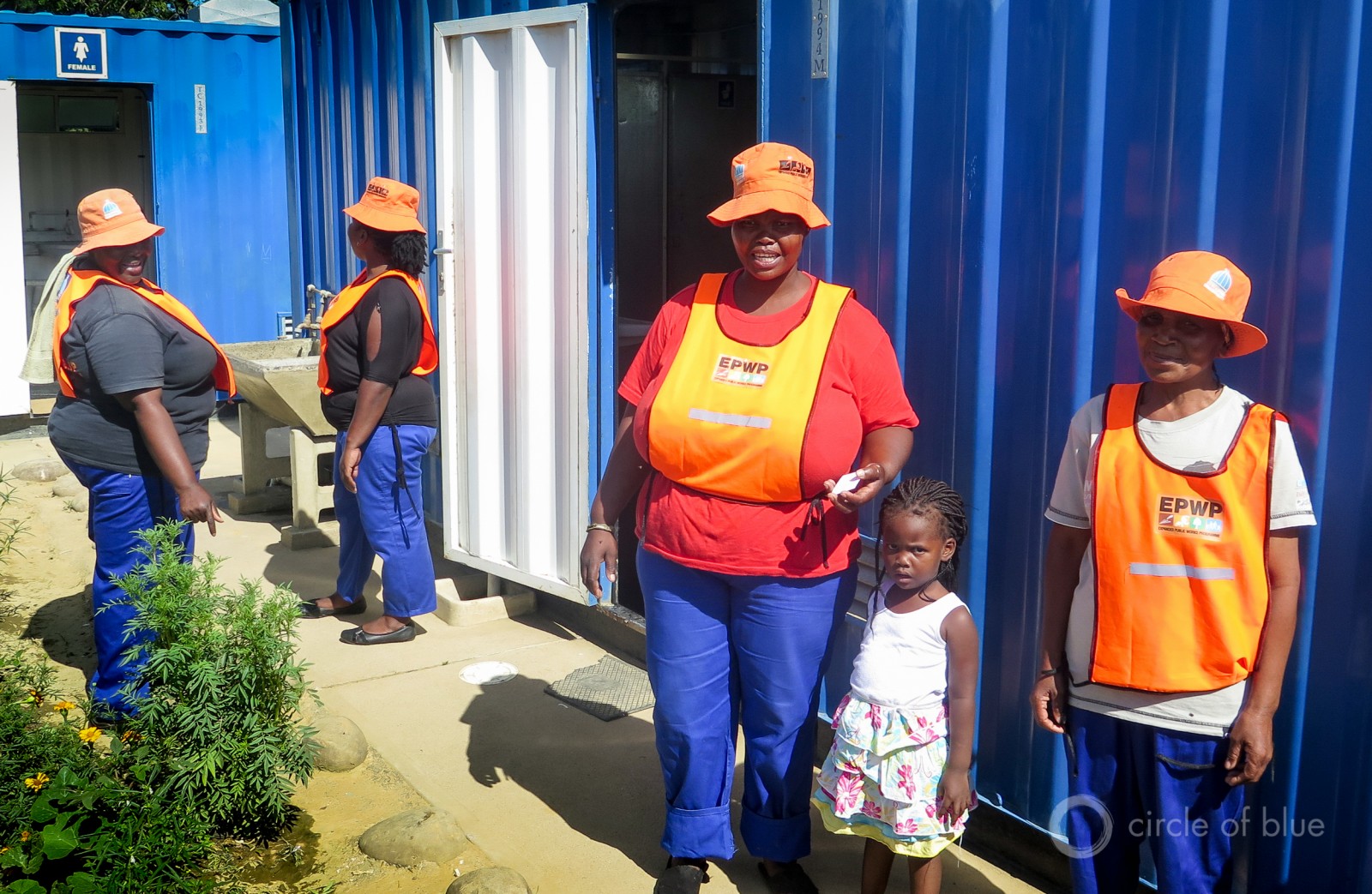
Ablution blocks are marine cargo containers refitted as public washrooms with sinks, wash basins, toilets and showers. Separate washrooms for men and women are kept clean by managers paid by the municipality. Photo © Keith Schneider / Circle of Blue
It also developed working partnerships with ward leaders to recruit citizen support and improve programs. The locations of ablution blocks, for example, are decided by leadership groups within settlements. The city views them as temporary facilities. A separate city office is building permanent housing, sometimes in wards where ablution blocks exist and need to be removed.
In many wards, the washrooms are seen as valuable and likely to be permanent fixtures. In early January, Gouden’s program notified the Amaoti settlement in Ward 53, where 12,000 people live, to expect 16 new ablution blocks. The community’s 25-member elected leadership council met to consider spaces among the densely packed dwellings that were large enough for separate men’s and women’s wash houses and sufficiently dispersed to serve residents. Doctor Zungu, who has lived in the community all of his 45 years and heads the infrastructure committee, was assigned to lead the project.
He said in an interview that choosing the sites took minutes.
Ward Collaboration
“We know the ward,” said Zungu. “All of us know each and every corner of this ward. If the leadership says put one in that corner, I know exactly that corner. It took us ten minutes to decide, under ten minutes.”
“We are trying to bring [ablution blocks] to communities as fast as we can. The need is very big.”
— Sibongile Buthelezi,
Community development specialist
eThekwini Water and Sanitation
Sibongile Buthelezi, a community development specialist with the city’s Water and Sanitation unit, explained that once the sites for new ablution blocks are firm, city engineers and a local construction management contractor draw up plans for site preparation, building water lines, and installing the units. It costs about 1 million rand ($US 65,000) to build and install an ablution block.
“We are trying to bring them to communities as fast as we can,” she said. “The need is very big.”
Another essential collaboration is with the University of KwaZulu-Natal’s Pollution Research Group. Scientists and engineers at the center reworked urine-diverting toilets, designed in Sweden to separate waste streams at the source and serve island vacation homes, to operate under much more intense use in Durban’s settlements. The university helped prove the safety and effectiveness of the ablution blocks, which are fabricated by a local industrial firm. The city and the university established a research center to test ideas, including a waste-to-compost program using black soldier fly larvae to hasten the conversion. A pilot plant, built with the help of BioCycle, a South African research and development company, is under construction at one of Durban’s 27 wastewater treatment plants.
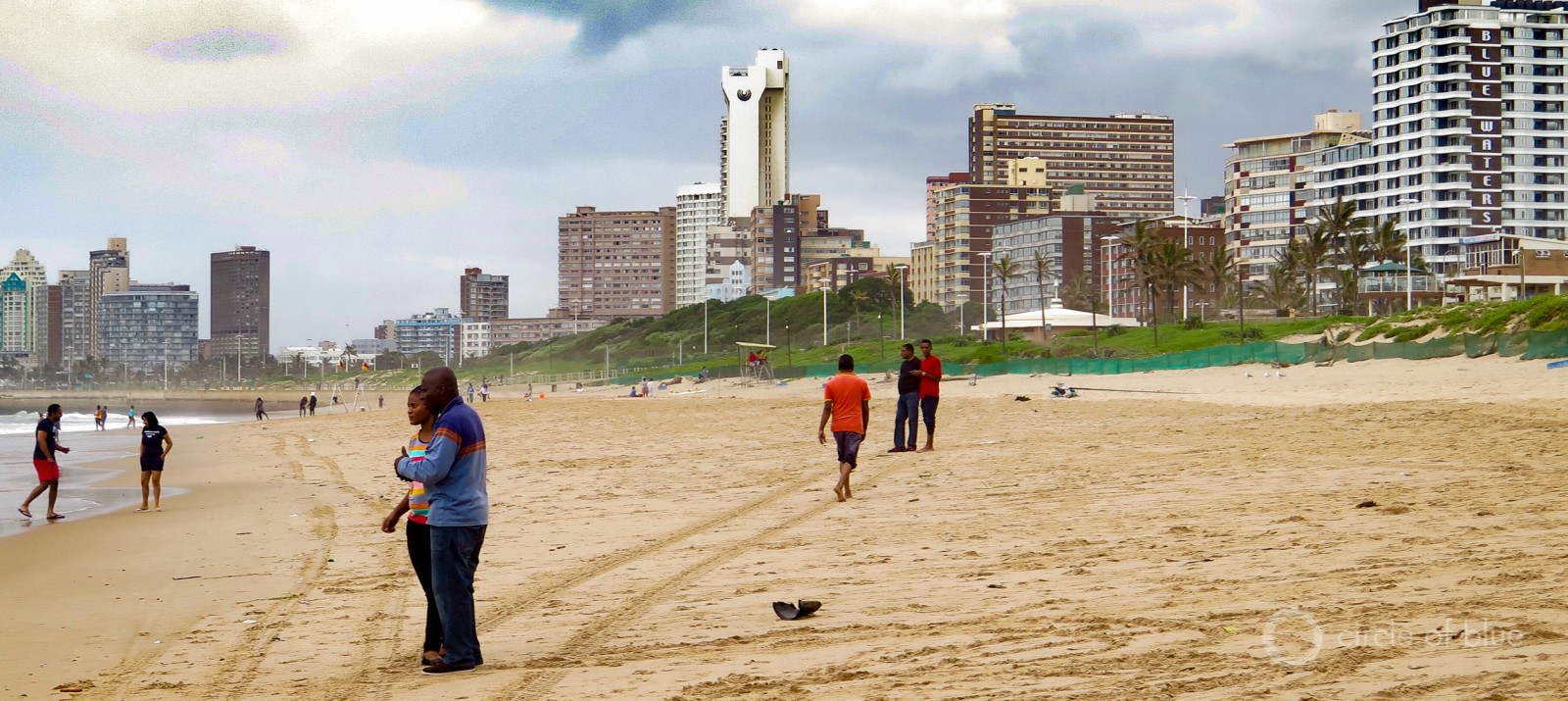
The city’s hillside settlements cascade down to Durban’s Indian Ocean beachfront. South Africa’s second largest city supports a thriving summer beach tourism industry. Photo © Keith Schneider / Circle of Blue
Durban is not content. It is now testing in-home toilets that use no water, generate sufficient energy to power a light bulb, and produce safe nutrient-rich byproducts that can be distributed or sold as soil amendments. The city’s willingness to innovate and experiment attracted the attention of Bill Gates, who, when visiting in 2009, was splashed with feces during a demonstration of waste removal from a pit toilet. He made Durban one of four sites charged in his foundation’s Reinventing the Toilet program to prove the feasibility of water-free sanitation.
Bill Gates Involved
The Bill & Melinda Gates Foundation’s Water, Sanitation, and Hygiene program is investing about $US 1 million a year in Durban and the University of KwaZulu-Natal to develop water-free waste disposal.
“They’ve been dealing at a highly functional level addressing their sanitation issues long before the foundation focused on sanitation,” said Carl E. Hensman, a water and sanitation program officer at the Gates Foundation. “While many others in the sanitation sector have spent three or four decades looking at the sanitation problem, they have often been constrained to traditional approaches. eThekwini Water and Sanitation, contrary to the more traditional belief, bucked the trend and quickly came to the conclusion that the traditional approach to sanitation in developing countries is not sustainable. Like the foundation, they initially had their fair share of detractors and critics. But they always moved forward with confidence. They are reaping the benefits of their flexibility, innovation and vision.”
“eThekwini Water and Sanitation, contrary to the more traditional belief, bucked the trend and quickly came to the conclusion that the traditional approach to sanitation in developing countries is not sustainable.”
— Carl E. Hensman,
Program officer
Bill & Melinda Gates Foundation
Water, Sanitation, and HygieneThe goal of treating human waste without using water is viewed here as useful in every way to Durban’s development and reputation. A year-long drought is lowering water levels in storage reservoirs and prompting water use restrictions. The city’s rivers are regularly inundated with fecal contamination as treatment plants and pumping stations fail. The more than 400 pumping stations needed to carry wastes over Durban’s hills are preyed upon by thieves who steal wiring, pipes, and equipment. When the pump stations shut down, sewage backs up and spills into streams that carry the filth to the sea. Beaches in and outside the city have big signs that provide daily reports of fecal coliform bacteria counts, and post warnings when it is unsafe to go in the water.
“We cannot continue to use clean potable water to flush our wastes. We have to find a way to stop that. It’s got to happen,” said Teddy Gounden. “The new thinking is to look at waste as a resource and take away all the aspects of using water to flush waste away. If you take that away you have enough water for all of us.”
A version of this article was published on Citiscope on February 12, 2016.
Circle of Blue’s senior editor and chief correspondent based in Traverse City, Michigan. He has reported on the contest for energy, food, and water in the era of climate change from six continents. Contact
Keith Schneider



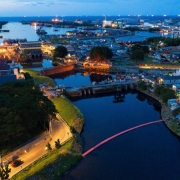
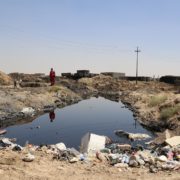
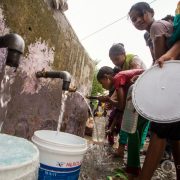

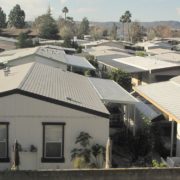



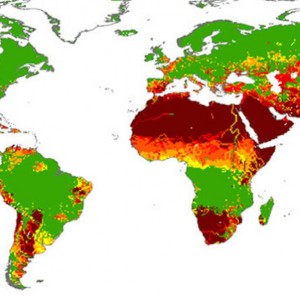
Leave a Reply
Want to join the discussion?Feel free to contribute!